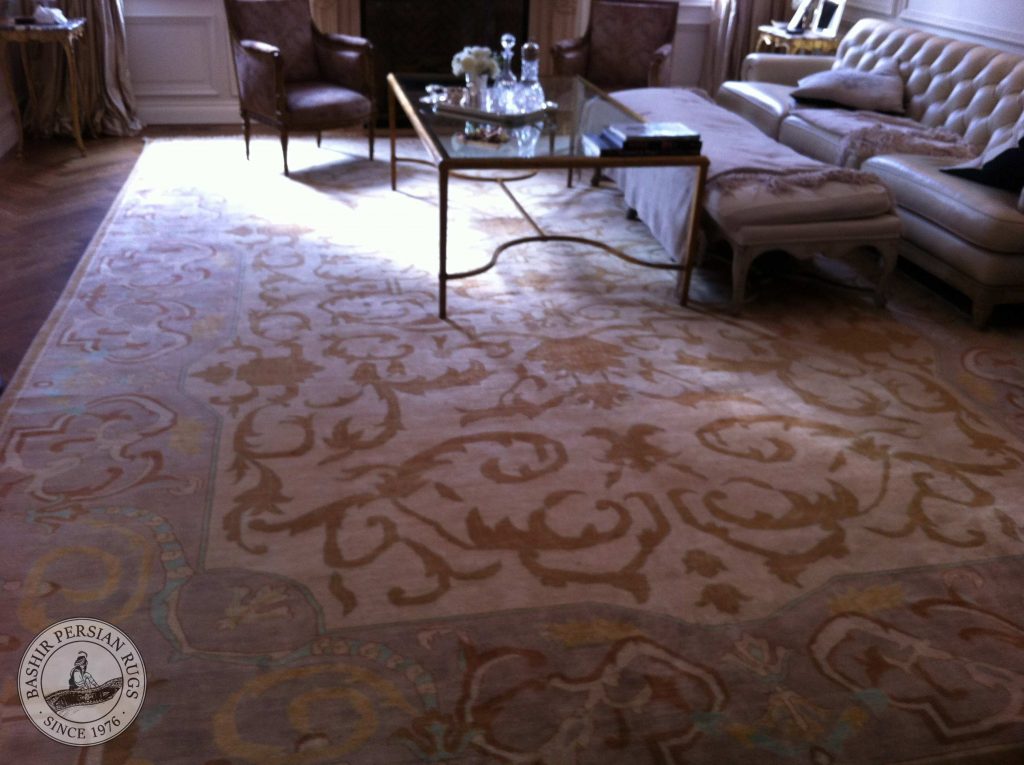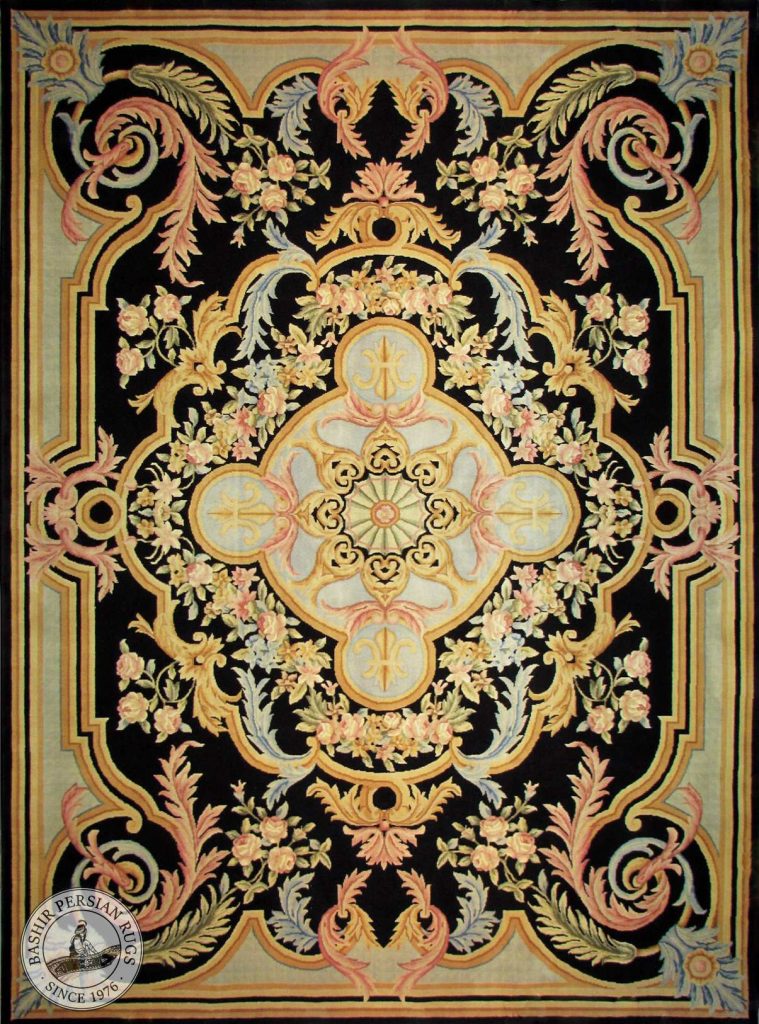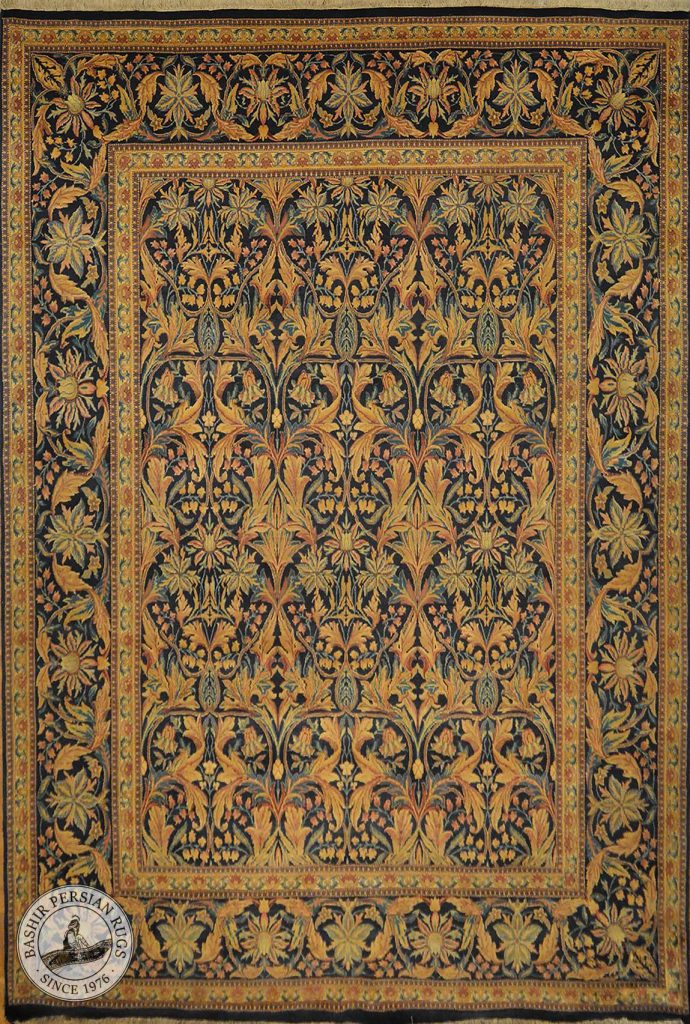
The Most Popular French Rugs
Several clients contact us on a regular basis to get information on French style carpets. Below, you will find two sections on the most sought-after styles: Aubusson Rugs & Savonnerie Rugs.
Aubusson Rugs
Aubusson Carpets are fine carpets woven in France between the 15th to the 19th centuries. Aubussons were crafted with the assistance of architects and artists of the French royal court. They were originally made in France as a pileless carpet with a floral medallion in pastel colors. Today’s Aubussons are woven in India and China and have been adapted by the addition of a pile. The Aubusson area was best known as an important tapestry-weaving center until, in an attempt to meet the great demand for knotted carpets, the King’s Council set up a carpet-weaving enterprise there in the early 1740s. Initially the carpets were copies of imported Turkish designs. Louis XV and Madame de Pompadour were among the first clients, placing orders through agents in Paris.
Sadly, the demand for oriental rugs did not last and the artist Pierre-José Perrot, who had already been involved with designing Savonnerie carpets, was called upon to design carpets in the French style in 1750. Another painter, Le Lorrain, produced a radical new design, “grande mosaic”, which was a sophisticated precursor to the 19th century floral carpets. A central medallion of flowers is surrounded by dainty rosettes, flowers and garlands.
Aubusson carpets were originally made as both knotted-pile carpets and later in the 18th century as flatwoven slit-tapestry technique carpets produced in the same way as their tapestries. The Aubussons that are popular and readily available today are typically flatweaves. The Aubusson floral tradition was never completely abandoned, although the trend began to lean towards the neo-classical Empire style created by two architects (Percier and Fontaine) after the Proclamation of the French Empire in 1804. That gave rise to elegant Savonnerie and Aubusson carpets whose patterns are influenced by antique classical trophies or Etruscan and Roman motifs.

Renaissance Collection
These tend to be in a dark rich palette, sometimes in different shades of the same color, resulting in a multi-dimensional look. Nineteenth-century Aubusson tapestry-woven carpets, which were produced in great quantities, are popular today with interior decorators in Europe and North America. Trailing ribbons, bows and blowsy roses woven in soft pastel shades – of rose, dovey greys, cafe-au-lait and pale yellows conjure a very feminine look well suited for sitting rooms and bedrooms. Seventeenth and eighteenth-century Aubusson carpets in good condition are rare finds. As such an Aubusson in good condition garners a high price.
Savonnerie Rugs

The early history of carpets in France is tied to the story of two weaving ateliers, Savonnerie and Aubusson. There are earlier references to carpets being woven in France before the seventeenth century, but no examples survive.
The granting of a license by Henri IV to Pierre Dupont in France, 1608, to manufacture Savonnerie carpets is similar in spirit to the establishment of court workshops by the Mughals and Safavids, whose common aim was to produce superlative works of art, including carpets. In 1627 Louis XVIII gave a royal privilege to Dupont (1577-1640) and his pupil Simon Lourdet (d.1671) for weaving carpets. They set up business in an old soap factory, hence the name Savonnerie, which quickly became the label attached to the products of the factory – carpets, panels and wall hangings – all created exclusively for the court. From the beginning, individual designers were employed to create designs, all of which were European in style.
Unlike early American or British carpets, no attempt seems to have been made by the Savonnerie atelier to emulate oriental carpets. A law was passed to prohibit the importation of carpets from the East to France in order to safeguard the Savonnerie workshop, which was granted a monopoly for the weaving of knotted-pile carpets. The seventeenth-century Savonnerie carpets have an opulent grandeur associated with them. Until 1768 the factory worked chiefly, if not exclusively, for the court, producing pile carpets only.
The richness of the colours used and the supremely confident manner with which acanthus scrolls, classical motifs and floral motifs were handled, combined to create a sumptuous effect worthy of any royal household. In 1663, Colbert, one of Louis XIV’s ministers, stipulated that a painter from the Royal Academy had to oversee the designs of the carpets and to teach drawing to the staff every month. Several important painters were associated with Savonnerie in this way, notably Charles Le Brun and, later in the eighteenth century, Francois Boucher.

Austere state economies, due to the financial problems arising from the wars in the latter part of Louis XIV’s reign, were largely responsible for the decline of the factory between 1690 and 1712. However, it was later revived and produced very pretty feminine carpets akin to the prevailing styles in the other decorative arts of the era. Soft colours, delicately drawn flowers, floral swags and ribbons are typical. Its heyday was over and by the beginning of the nineteenth century, cheaper Aubusson carpets became popular, although Napoleon employed the factory to weave handsome Empire-style carpets. In 1825, Savonnerie was amalgamated with the Gobelins tapestry factory and its independent existence came to an end. To read more about french rugs and their history, visit our French Rugs section.
Sources and inspiration: Bérinstain, Valérie, et al. L’art du tapis dans le monde (The art of carpets in the world),. Paris: Mengès, 1996. Print.; Jerrehian Jr., Aram K.A. Oriental Rug Primer. Philadelphia: Running Press, 1980. Print.; Herbert, Janice Summers. Oriental Rugs, New York: Macmillan, 1982. Print.; Hackmack, Adolf. Chinese Carpets and Rugs, Rutland and Tokyo: Tuttle, 1980. Print. ; De Moubray, Amicia, and David Black. Carpets for the home, London: Laurence King Publishing, 1999. Print.; Jacobsen, Charles. Oriental Rugs A Complete Guide, Rutland and Tokyo: Tuttle, 1962. Print.; Bashir, S. (n.d.). Personal interview.; Web site sources and dates of consultation vary (to be confirmed). Without prejudice to official usage.



 Runner Rugs
Runner Rugs 2x3 Area Rugs
2x3 Area Rugs 3x5 Area Rugs
3x5 Area Rugs 4x6 Area Rugs
4x6 Area Rugs 5x7 Area Rugs
5x7 Area Rugs 6x9 Area Rugs
6x9 Area Rugs 8x10 Area Rugs
8x10 Area Rugs 9x12 Area Rugs
9x12 Area Rugs 10x14 Area Rugs
10x14 Area Rugs Round Rugs
Round Rugs Bath Mats
Bath Mats Doormats
Doormats 12x15 Area Rugs
12x15 Area Rugs

